Think people aren't watching how you handle yourself at the dinner table?
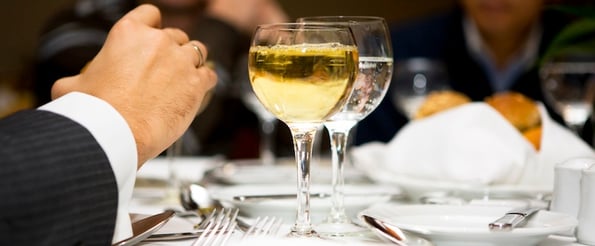
Think again.
Whether you're dining with a recruiter, prospective business partner, or your boss of several years, you should always follow the rules of proper dinner etiquette.
There's a reason people conduct business over a meal: It's a strategic way to get to know someone. How you behave before, during, and after the meal tells your host a lot about your character, your professionalism, and your social awareness.
When it comes to business dining, there are a lot of little tidbits to remember. Which bread plate is yours? What should you order to drink? How do you get rid of that pesky ketchup stain?
Don't worry: We're here to help. Follow this guide for 29 business etiquette tips so you can make a great impression at your next business dinner.
Note: This is a roundup of common business etiquette tips, but be mindful that there are places in the world where some of these tips don't hold true. If you're dining in a country that uses etiquette you're unfamiliar with, take the time to look up the etiquette for that specific country, or ask a friend or colleague ahead of time.
Before the Meal
1) Eat a little something ahead of time.
You may be going to an awesome restaurant with delicious food, but you that doesn't mean you should show up super hungry. If you do, you risk focusing more on your food than on the conversation. Have a little snack before you head to dinner, like a protein bar, a piece of fruit, or some cheese and crackers.
2) Dress appropriately.
I wish there were a simple answer to the question of what to wear, but it really does depend on the context. As with any work event, the culture of the company or industry hosting the dinner should be your first clue. Is your host from a financial firm? Lean toward the formal side of business casual. Meeting with someone from a tech startup that tends to be a little more casual? Stick to business casual, but relax your look a bit. For specific details, here's a guide to what business casual entails.
Another clue is the dinner venue. Look up the restaurant's website ahead of time and see what vibe you get. And when in doubt, overdressing is better than underdressing.
3) Silence your cell phone.
This should be a no-brainer. Keep in mind a vibrating phone is as bad as a ringing one. Turn it on silent, put it away, and don't take it out while in the presence of your host.
4) Plan to arrive on time.
Plan your travel well in advance so you're sure to arrive on time, or even a little bit early, just to be safe. If you're going to be late -- hey, it happens -- be sure to call your host and/or the restaurant to let them know. If your host is late, wait at least 15 minutes before checking in on them.
On Arrival
5) Shake hands with everyone.
Greet everyone with a firm handshake accompanied by good eye contact, and introduce yourself to anyone you don't know. Concentrate on remembering people's names -- especially the host's, as you'll need to remember it to thank them later.
6) Store your stuff under your chair.
It's always awkward trying to figure out where to stuff your bag, sunglasses, cell phone, or briefcase. The number one rule here is to not place anything on the table, no matter how small it is. The proper place for your bags are either under your chair, or wedged between your back and the back of the chair. Place your coat on a nearby coat hook, over the back of your chair, or under your chair with the rest of your belongings.
7) Wait to sit until your host sits first.
In many countries, it's polite to remain standing until your host has taken their seat. If there isn't a host, then wait for the most senior or oldest person at the table to sit first.
Note: In some countries, the host never sits before the guests, so try to figure out what the proper etiquette is beforehand if you're dining in an unfamiliar country.
8) Place your napkin in your lap right away.
As soon as you sit down, take your napkin off the table, unfold it, and put it on your lap with the open end of the fold facing away from you. Never, ever, tuck your napkin into the front of your shirt.
Speaking of napkin etiquette: If you have to leave the table at any point during your meal, place your napkin on your empty chair instead of on the table in front of you. This tells the server that you plan to return.
9) Familiarize yourself with the place settings.
For the vast majority of meals, you'll probably just be dealing with a fork, knife, and a spoon. But for the occasional fancy dinner, there's a chance you'll see a few more pieces -- and it's best to be prepared.
The general rule of thumb is that utensils are generally placed in the order of their use. So, when in doubt, start from the outside and work your way in. Another handy trick is to think of solids on your left, and liquids on your right. Wondering which bread plate is yours? It'll be the one on your left. Your water, wine, and coffee cups will be on your right.
Below is a simple diagram showing the anatomy of a table setting. A few things to note:
- The salad fork will be on the outside of your place fork (for the main dish), and it'll be smaller than your place fork.
- Forks usually go on the left, but if you ever see a small fork on your right, it's an oyster fork.
- Your water glass will always be on the left-hand side of your wine glass.

Image Credit: the kitchn
Ordering Your Food
10) Order a club soda with lemon.
In general, it's best to just not order alcohol at a business meal. Instead, Ross McCammon suggests ordering a club soda with lemon because it indicates to others that you'd likely have an alcoholic drink in another context. Iced tea is another good, non-alcoholic option.
If you do order a drink at dinner -- say, if your host encourages it -- then limit yourself to one beer or glass of wine. Pay attention to how quickly your host is drinking theirs, too, and drink yours more slowly than they do.
Note: In some countries, like Russia, offering someone a drink is a sign of trust and friendship, so don't turn it down if it's offered to you. Again, if you're unfamiliar with the local etiquette, look it up ahead of time or ask a friend or colleague.
11) Take note of what your host orders.
Pay attention to what your host orders to eat, as it'll give you an idea of what you should order. If they order an appetizer, you may want to order one, too. If the host isn't the first person to order, you might ask for his or her recommendation.
12) Be ready to place your order.
Order simply, and don't make a scene. You can ask your server a question or two, but don't ask them to explain everything on the menu or substitute ingredients -- unless you have a food allergy. Not only is it annoying, but you'll also appear indecisive.
13) Don't order the most expensive item.
It's rude to order the most expensive item on the menu. Save the lobster or the decadent red meat dishes for another time.
14) Don't order "trouble" foods.
Some foods can be a little difficult to eat. Save yourself the trouble -- and the embarrassment -- by just not ordering those foods.
Foods that are easy to eat include chicken, fish, or salads. Foods that aren't easy to eat are spaghetti, burgers, lobster, finger foods, anything with a lot of sauce, or anything that can get stuck in your teeth, like spinach, broccoli, and anything with seeds.
If you do get something on your clothing, here are some tips for removing the stain on the spot:
- Sauce stains: Pour some club soda directly onto the stain and rub into it with a damp, clean cloth or napkin.
- Red wine stains: Wet the stained area with water, sprinkle it with table salt, and rub one half of the stain against the other to work in the salt and loosen the stain. Then, wash the stain quickly with soap and water -- and throw it in the laundry as soon as you get home.
- Lipstick stains on dark fabrics: Remove the crust from a piece of white bread. Wad up the soft center with water, and rub it gently on the stain until it picks up all of the lipstick. Sweep away any leftover crumbs, and voilà.
How to Eat
15) Pour others' water before your own.
Is the table sharing a communal pitcher of water? Before adding more to your glass, check and fill others' glasses first. It's a polite gesture that others will take notice of.
16) Tear your bread and butter it piece by piece.
If bread's going to be served at your meal, you'll typically find a small side plate on the left side of your place setting. If the bread comes in a loaf, tear off a piece with your fingers -- never cut a piece off with a knife. When you want to eat your piece of bread, tear off a bite-sized piece with your fingers.
What about the butter? Since it's polite to only get butter from the butter dish once, use your butter knife to slice off a large amount of butter, and place it on the side of your bread plate. Tear a piece of bread and butter each one as you eat it, as opposed to of butter it all up front and then tearing off pieces.
If you're the first person to eat bread from the basket, the etiquette is to offer the bread basket to the person on your left and then begin passing the bowl around the table to the right.
Note: In France, bread is commonly used as a utensil instead of as a straight appetizer. When you're not using your bread, it's acceptable -- even preferred -- to place it on the table or tablecloth instead of the plate.
17) Wait for your host to begin eating before you start.
Don't pick up your fork and start eating until the host does so first. Don't start eating until everyone at the table has been served their food unless the host indicates that you can.
18) Hold your utensils correctly.
There is a "right" and a "wrong" way to hold your utensils, but it depends on the culture of the people you're eating with. (Of course, holding your utensils in a fist is always wrong, no matter where you are.)
Beyond that, there are two main styles for holding a fork and knife: continental style (i.e. European style) and American style. In both styles, you hold your fork in your left hand and your knife if your right, and you use the fork to hold the food while you cut it with the knife in your right hand. Once you cut a bite, the main difference comes in.
Continental Style (i.e. European Style)
Use the fork in your left hand to hold the food down while you cut it with the knife in your right hand. Once you cut a bite-sized piece off, keep the fork in your left hand (even if you're right-handed), and bring the piece of food to your mouth with the fork with the tines curving downward. In other words, the back of the fork will be facing upward as you bring it to your mouth.
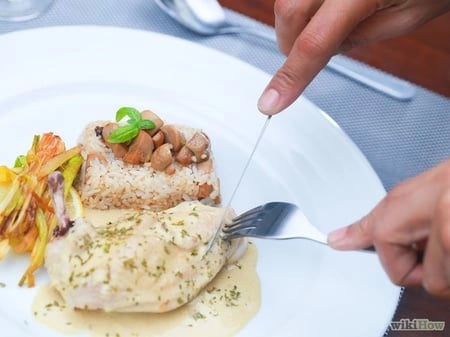
Image Credit: WikiHow
American Style
Use the fork in your left hand to hold the food down while you cut it with the knife in your right hand. Once you cut a bite-sized piece off, place your knife down on the edge of your plate -- blade at the twelve o'clock and handle at three o'clock -- and transfer your fork from your left hand to your right. Then, turn your fork so the tines are taking upward, and take a bite.

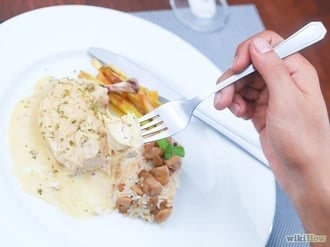
Image Credit: WikiHow
Speaking of utensil placement ... once you start eating, your utensils -- including the handles -- should never touch the table again. In other words, anytime you need to put your fork or knife down, be sure it's resting completely on your plate instead of propped up on the table against your plate.
Using Chopsticks?
Check out the diagram below for illustrated instructions on how to pick up and use chopsticks:

Image Credit: The Royal Garden
Keep in mind that it's impolite to use your chopsticks to point, spear your food, or dig through your food to find something in particular.
19) Rest your utensils correctly.
If you want to put your utensils down but you're not done eating, indicate so to your server either in continental style or American style, depending whom you're dining with.
Continental Style (i.e. European Style)
Place your knife (turned inward) and fork (tines down) together in an "X" position, anywhere between the clock positions of four and six.
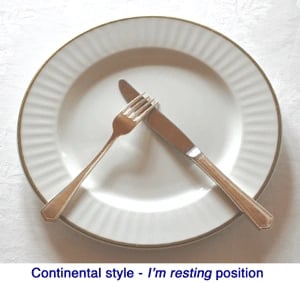
Image Credit: Image Resource Group
American Style
Place your knife on the edge of your plate at the one o'clock position (blade turned inward), and your fork (tines up) at the four o'clock position tilted slightly to the left.
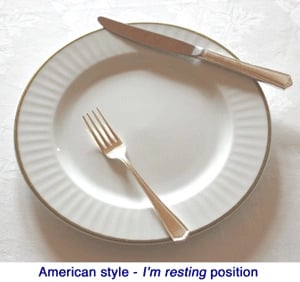
Image Credit: Image Resource Group
Note: In Thailand, don't eat using your fork. Instead, use your fork only to push food onto your spoon.
Using Chopsticks?
When you’re not using your chopsticks, place them in a chopstick holder if you’ve been given one, or side-by-side across the top of your bowl.
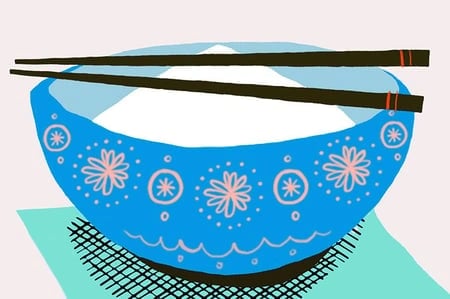
Image Credit: Exploration Online
Never rest your chopsticks by sticking them into your food.
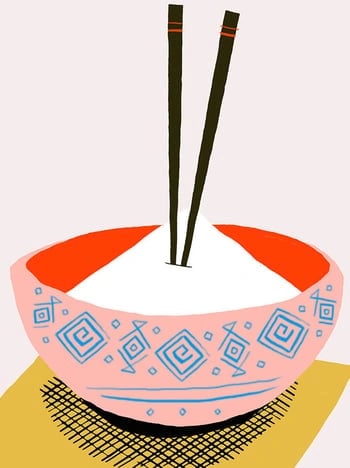
Image Credit: Exploration Online
20) Cut your food one piece at a time.
No matter where in the world you're located, be sure to cut your meat or meal one piece at a time instead of cutting it into many bite-sized pieces all at once. Likewise, cut your salad into bite-sized pieces so you aren't stuffing giant lettuce leaves into your mouth and splashing your face with dressing. (It's happened to the best of us.)
21) Spoon shared sauces onto your plate.
When you share a sauce with the table, don't dip your food into it. Instead, spoon some of it onto your plate, and dip from there.
22) Don’t blow on hot food to cool it down.
Turns out, it's rude to blow on food to cool it down. Patience, my friend: Just let it cool down by itself.
23) Drink soup from the edge of the spoon.
Not slurping isn't the only rule surrounding soup at the dinner table. In many countries, the proper etiquette is to dip the spoon sideways into the soup at the edge of the bowl closest to you, then skim from the front of the bowl to the back. Then, bring the spoon to your mouth and drink the soup from the edge of the spoon, instead of putting the whole spoon into your mouth.
To eat the last bit of soup from the bottom of the bowl, tilt the bowl away from you slightly to scoop it up with your spoon.
Note: In some countries, like Japan, slurping actually signifies your appreciation of your noodles and soups to the chef. You can also drink directly from the soup bowl, as spoons are uncommon.
24) Don't salt your food before tasting it.
It's considered an insult to the chef to salt your meal without tasting it first, because it's assumed you shouldn't know ahead of time which foods need salting and which don't.
25) Eat at a medium pace.
In other words, keep the ratio of food eaten equal to the others at the table. If there's a lot more food on your plate than the other person's plate, you might be talking too much. If there's less food on your plate than the other person's, you're not talking enough.
26) Don't overeat or undereat.
Don't overindulge, or you'll garner attention in a bad way. And never ask to finish anyone else's food. At the same time, don't forego your meal -- that doesn't send a great message, either.
27) When you're done, place your utensils in the "I'm finished" position.
Finished eating? Indicate so to your server either in continental style or American style, depending whom you're dining with.
Continental Style (i.e. European style)
Place your fork (tines down) and knife side-by-side on your plate with the handles at four o'clock.
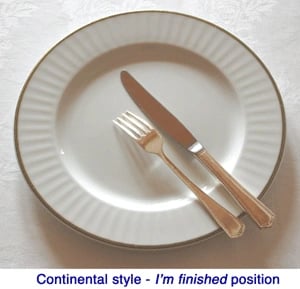
Image Credit: Image Resource Group
American Style
Place your fork (tines up) and knife side-by-side on your plate with the handles at four o'clock.
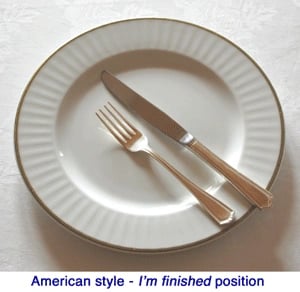
Image Credit: Image Resource Group
28) Make the "move" to pay, even if you don't expect to.
Although the host who invited you to dinner is obligated to take care of the check, it's still polite to make the "move" to pay. You know, the move where you tentatively reach for your wallet. At this point, the host should intervene and say they've got it covered -- at which point you should not argue, nor should you offer to pay the tip.
29) Don't forget to thank your host.
At the end of the meal, be sure to thank the host by name. Shake their hand and maintain good eye contact. Later, you might consider thanking them again by way of an email or a handwritten note.
There you have it. We hope these tips were helpful -- happy dining!
What are your tips for business dinners? Share with us in the comments.
